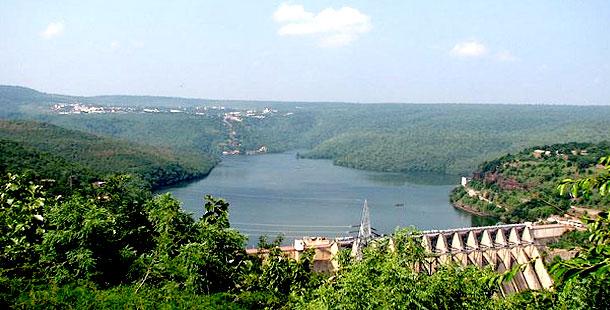Mud accumulations ruin Srisailam reservoir in 30 years?

The answer is 'yes', according to the engineering experts. Srisailam reservoir is losing 2.5 tmc of water storage level every year.
The present storage level is just 215.8 tmc as against its total storage capacity of 308 tmc; it will further dip in the years to come. The reservoir capacity has already been reduced by 92.25 tmc owing to continuous accumulations of mud into the dam. If the mud reach the river at the same pace, the reservoir will remain as a ruined monument in 30 years, warn the engineering experts. A survey conducted by the experts revealed startling facts. As a result of mud accumulations, crops in about 28 lakh acres are under the verge of complete withering.
Srisailam Reservoir & its features
- Construction of reservoir began in 1960
- Completed in 1981
- Built in between encircled hill ranges
- Height of the dam - 885 feet
- Full Reservoir Level (FRL) - 308.06 (As estimated in 1976)
- Power projects - 2
- Total power project capacity: 1,670 mw
- Right power project capacity: 770 mw
- Left power project capacity: 900 mw
The future of Srisailam project is hanging balance as mud accumulations reaching alarming level in the river bed reducing its storage capacity drastically. The State Government had ordered for project surveys thrice. The fist survey conducted in 1997, which found that the storage level came down by 44.45 tmc. The second survey in 2006 found a reduction of 73.41 tmc of its capacity and the third survey held in 2011, reported that the water storage capacity was reduced to 92.25 tmc. The present storage capacity stands at 215.8 tmc. As the mud accumulation is posing a threat, the storage level is decreasing from 2.11 to 2.63 tmc every year.
Series of floods posing threat
Krishna river is the third longest river in the country with nearly 1,400 km-long. The river rises at Mahabaleswar, about 1,337 feet above the sea level. Srisailam reservoir is built amidst the eastern ghats with an aim to generate power and supplying water to Krishna delta. There are floods for Krishna river several times. In 2009, an unprecedented flood created havoc with which about 14.8 lakh gallons cusecs of water reached the dam in a record period of 78 hours. The water level touched 896.5 feet as against its total capacity of 900 feet. With series of floods over the years, mud accumulations have caused a major blow to Srisailam reservoir reducing its storage levels.
Why dredging is impossible?
Usually, any reservoir or dam will have a facility for dredging. Whereas Srisailam is located amidst the mountains and the dumping the dredged mud is a major problem. Even if the mud is dumped on the hill slopes, it will rejoin the river during the rains. So there is absolutely no chance for dredging, the experts felt. However, the possibility of transporting the dredged mud to distant places is not ruled out, but is an herculean task.
What is solution?
Mud accumulations are common phenomenon in reservoirs. The issue of dredging is understood to have ignored at the time of project execution. A common practice is in vogue in western countries that a separate reservoir is built for dredging purpose. The mud sludge will be filtered before water reaching the main dam. Krishna river has no such facility on upward stream except the Alamatti dam in Karnataka. It is a blessing in disguise for Andhra farmers as some quantum of mud is prevented without reaching Srisailam reservoir.
Other reasons attributed for mud accumulations are declining vegetation on riparian regions and conversion of banjar lands into agricultural lands. The dip in storage capacity will badly hit the farming sector. The experts observed that about 28 lakh acres of ayacut will affect with the depletion of water levels.
-Sakshipost





